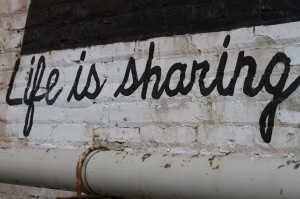This year, one of the big buzz phrases seems to be “collaborative economy.” Also called “the sharing economy,” Wikipedia defines this concept as “a socio-economic system built around the sharing of human and physical assets.
It includes the shared creation, production, distribution, trade and consumption of goods and services by different people and organizations. These systems take a variety of forms, often leveraging information technology to empower individuals, corporations, non-profits and government with information that enables distribution, sharing and reuse of excess capacity in goods and services.”
In addition to being a hot idea, the collaborative economy is, according to Jeremiah Owyang, a big money maker. In a post titled, “Why Investors Are in Love with the Collaborative Economy,” Owyang writes, “In 2013, average funding was $29 million. In 2014, the average funding amount is $102 million due to outliers, like Uber, receiving over $1.2 billion.” This all sounds great, but how can your organization get in on the action?
There are really two ways you can look at jumping into the collaborative economy. You can use it to help maximize your own organization’s efficiency or you can find ways to use it in order to help the people you most want to help. Let’s explore both of these concepts in more detail.
Using the Collaborative Economy to Benefit Your Organization
There are numerous companies involved in the sharing economy geared towards helping companies and organizations run more smoothly. In another post, Owyang outlines several organizations geared towards the business end of society. Although the post mentions B2B specifically, you can easily see how something like Selfstarter would be perfect for an NPO. Better known companies in the sharing economy could also easily help your organization out. If you are just getting started or if your funding isn’t where you need it to be, space-sharing organizations could help you out. If a lot of your employees or volunteers are without transportation, a collaborative economy organization like Lyft could perhaps partner with you to help them get to work. On the business side of things, there are countless ways for your organization to participate as a beneficiary of the collaborative economy.
Using the Collaborative Economy Concept to Benefit the People You Want to Help
There are already organizations that have actually been built on the idea that you can share your resources with people who need them. Women with Drive is a prime example of this. Although probably not considered your classic example of a collaborative economy company, the concept behind Women with Drive fits right in. An organization that has a resource (cars in this case) gives access to women who do not have cars. It’s not a hand-out – the women have to make it work – but it gives them a much-needed boost.
Another charitable organization using concepts common to the collaborative economy is SMAC! Sock Monkeys Against Cancer. The most recent development with SMAC is the concept of Angel Matching. SMAC uses its resource—people willing to donate money—to help make sure people who request a sock monkey can indeed get one.
Based on these ideas, can your organization involve itself in the collaborative economy? Perhaps you have readily available buses that stand idle on some days. Could those be used to help disadvantaged kids take a field trip? Maybe you get a lot of donations of clothing that you can’t specifically use. Maybe you can hook up with another organization and use your resource (the donors) to help them out.
What do you think? Are you on the cusp of joining the collaborative economy? We’d love to hear from you!
